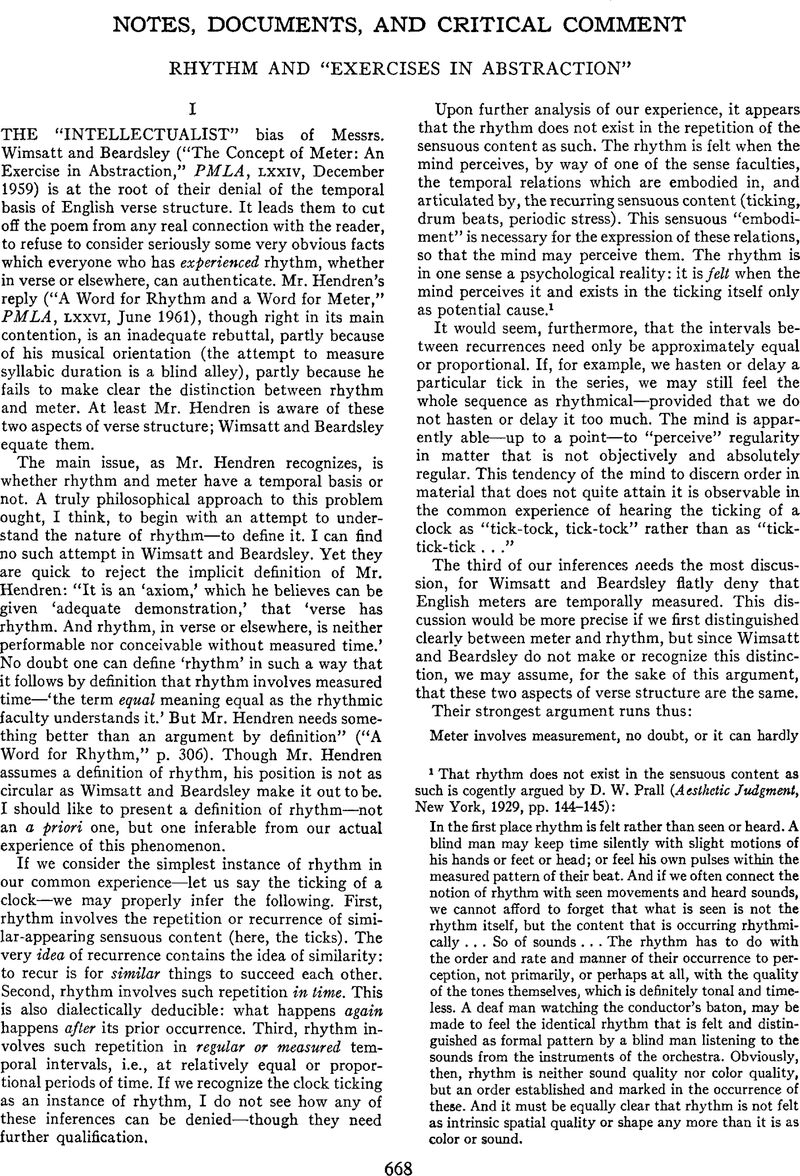Article contents
Rhythm and “Exercises in Abstraction”
Published online by Cambridge University Press: 02 December 2020
Abstract

Information
- Type
- Notes, Documents, and Critical Comment
- Information
- Copyright
- Copyright © Modern Language Association of America, 1962
References
Note 1 in page 668 That rhythm does not exist in the sensuous content as such is cogently argued by D. W. Prall (Aesthetic Judgment, New York, 1929, pp. 144–145):
In the first place rhythm is felt rather than seen or heard. A blind man may keep time silently with slight motions of his hands or feet or head; or feel his own pulses within the measured pattern of their beat. And if we often connect the notion of rhythm with seen movements and heard sounds, we cannot afford to forget that what is seen is not the rhythm itself, but the content that is occurring rhythmically … So of sounds … The rhythm has to do with the order and rate and manner of their occurrence to perception, not primarily, or perhaps at all, with the quality of the tones themselves, which is definitely tonal and timeless. A deaf man watching the conductor's baton, may be made to feel the identical rhythm that is felt and distinguished as formal pattern by a blind man listening to the sounds from the instruments of the orchestra. Obviously, then, rhythm is neither sound quality nor color quality, but an order established and marked in the occurrence of these. And it must be equally clear that rhythm is not felt as intrinsic spatial quality or shape any more than it is as color or sound.
Note 2 in page 669 Rhythm may, of course, be involved in the spatial arts. But when we say that a painting has rhythm, what we mean (unless we are using a dubious metaphor) is that the eye of the beholder moves in time over regularly recurring elements in the painting and feels this recurrence as a regularly timed pattern. What is involved, then, is a temporal pattern, though it may look, at first glance, like a spatial one.
Note 3 in page 669 The senses themselves are not percipient of rhythm, even though rhythm becomes known ordinarily through the sense of hearing or sight. Sense perception is always immediate: we perceive this or that sound or object now, and such a datum is not itself rhythmical.
Note 1 in page 672 The relation between the spoken words of the poem and the meter is analogous to that between Plato's Ideas and their concrete images. The Ideas are supremely real and perfect, but we come to know of them only by way of their imperfect imitations in the actual world.
Note 2 in page 672 The Function of Criticism (Denver, 1957), p. 82. For an excellent statement of the relation of meter to rhythm in music, see Igor Stravinski, Poetics of Music (Vintage Books, New York, 1956), pp. 29–30.
Note 3 in page 673 The fact that no two performances of a poem are exactly alike does not disprove the temporal basis of English verse. Performances, especially by those who do not respond to rhythm, may be quite bad. But apart from this, even good performances will vary one from another. Two points need to be made here. Temporal equivalence is never absolute—and it does not have to be, since rhythm is a psychological, not a mechanical, phenomenon. Secondly, good performances, however they vary, will never vary so much as to destroy the sense of a basic time scheme. Hendren (“A Word for Rhythm,” p. 301) makes the same point.
- 1
- Cited by

